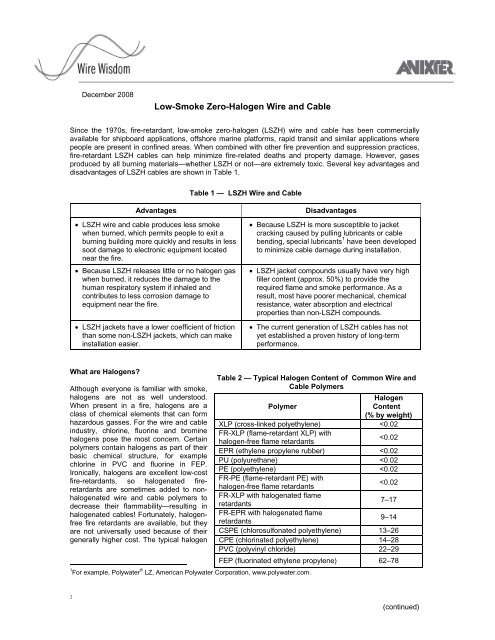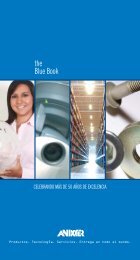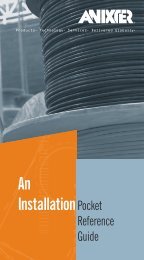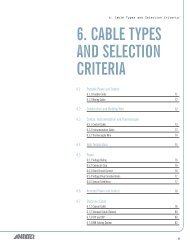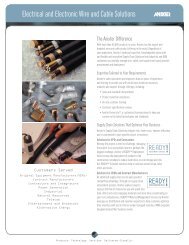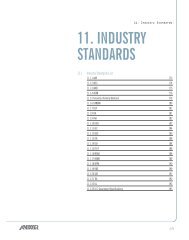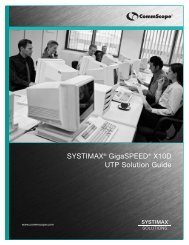Low-Smoke Zero-Halogen Wire and Cable - Anixter
Low-Smoke Zero-Halogen Wire and Cable - Anixter
Low-Smoke Zero-Halogen Wire and Cable - Anixter
Create successful ePaper yourself
Turn your PDF publications into a flip-book with our unique Google optimized e-Paper software.
1<br />
December 2008<br />
<strong>Low</strong>-<strong>Smoke</strong> <strong>Zero</strong>-<strong>Halogen</strong> <strong>Wire</strong> <strong>and</strong> <strong>Cable</strong><br />
Since the 1970s, fire-retardant, low-smoke zero-halogen (LSZH) wire <strong>and</strong> cable has been commercially<br />
available for shipboard applications, offshore marine platforms, rapid transit <strong>and</strong> similar applications where<br />
people are present in confined areas. When combined with other fire prevention <strong>and</strong> suppression practices,<br />
fire-retardant LSZH cables can help minimize fire-related deaths <strong>and</strong> property damage. However, gases<br />
produced by all burning materials—whether LSZH or not—are extremely toxic. Several key advantages <strong>and</strong><br />
disadvantages of LSZH cables are shown in Table 1.<br />
Table 1 — LSZH <strong>Wire</strong> <strong>and</strong> <strong>Cable</strong><br />
Advantages Disadvantages<br />
• LSZH wire <strong>and</strong> cable produces less smoke<br />
when burned, which permits people to exit a<br />
burning building more quickly <strong>and</strong> results in less<br />
soot damage to electronic equipment located<br />
near the fire.<br />
• Because LSZH releases little or no halogen gas<br />
when burned, it reduces the damage to the<br />
human respiratory system if inhaled <strong>and</strong><br />
contributes to less corrosion damage to<br />
equipment near the fire.<br />
• LSZH jackets have a lower coefficient of friction<br />
than some non-LSZH jackets, which can make<br />
installation easier.<br />
• Because LSZH is more susceptible to jacket<br />
cracking caused by pulling lubricants or cable<br />
bending, special lubricants 1 have been developed<br />
to minimize cable damage during installation.<br />
• LSZH jacket compounds usually have very high<br />
filler content (approx. 50%) to provide the<br />
required flame <strong>and</strong> smoke performance. As a<br />
result, most have poorer mechanical, chemical<br />
resistance, water absorption <strong>and</strong> electrical<br />
properties than non-LSZH compounds.<br />
• The current generation of LSZH cables has not<br />
yet established a proven history of long-term<br />
performance.<br />
What are <strong>Halogen</strong>s?<br />
Table 2 — Typical <strong>Halogen</strong> Content of Common <strong>Wire</strong> <strong>and</strong><br />
Although everyone is familiar with smoke,<br />
<strong>Cable</strong> Polymers<br />
halogens are not as well understood.<br />
<strong>Halogen</strong><br />
When present in a fire, halogens are a<br />
Polymer<br />
Content<br />
class of chemical elements that can form<br />
hazardous gasses. For the wire <strong>and</strong> cable<br />
industry, chlorine, fluorine <strong>and</strong> bromine<br />
halogens pose the most concern. Certain<br />
polymers contain halogens as part of their<br />
basic chemical structure, for example<br />
chlorine in PVC <strong>and</strong> fluorine in FEP.<br />
Ironically, halogens are excellent low-cost<br />
fire-retardants, so halogenated fireretardants<br />
are sometimes added to nonhalogenated<br />
wire <strong>and</strong> cable polymers to<br />
decrease their flammability—resulting in<br />
halogenated cables! Fortunately, halogenfree<br />
fire retardants are available, but they<br />
XLP (cross-linked polyethylene)<br />
FR-XLP (flame-retardant XLP) with<br />
halogen-free flame retardants<br />
EPR (ethylene propylene rubber)<br />
PU (polyurethane)<br />
PE (polyethylene)<br />
FR-PE (flame-retardant PE) with<br />
halogen-free flame retardants<br />
FR-XLP with halogenated flame<br />
retardants<br />
FR-EPR with halogenated flame<br />
retardants<br />
(% by weight)<br />
(continued)<br />
content of some common cable polymers are shown in Table 2.<br />
Industry St<strong>and</strong>ards<br />
Various abbreviations are used to refer to low-smoke zero-halogen cables around the world. In addition to<br />
LSZH, other common names include LSF (low smoke <strong>and</strong> fume), LSHF (low smoke halogen free) <strong>and</strong> LS0H<br />
(low smoke zero halogen). These names have no official definition, but numerous test methods have been<br />
developed <strong>and</strong> published by industry organizations to define specific levels of performance. A few terms that<br />
do have official definitions are described below.<br />
Plenum Rated: In the United States, a cable must pass the smoke emission <strong>and</strong> fire propagation<br />
requirements contained in NFPA 262 2 to be plenum rated. This industry st<strong>and</strong>ard specifies<br />
maximum permissible values for flame spread <strong>and</strong> optical density of evolved smoke, but it does not<br />
specify halogen content. The NEC 3 requires plenum-rated cables such as types CMP <strong>and</strong> CL2P in<br />
certain applications, including ducts, plenums <strong>and</strong> other spaces used for environmental air<br />
h<strong>and</strong>ling, such as those above suspended ceilings.<br />
LS Rated: UL st<strong>and</strong>ards define LS-rated wire <strong>and</strong> cable differently, depending on the type of<br />
product. For single-conductor wire types that must meet the requirements of UL 44 3 or UL 83 4 such<br />
as XHHW, RHW, RHW-2, THW <strong>and</strong> THWN, an LS-rated wire must meet specific values for flame<br />
spread, smoke emission <strong>and</strong> halogen acid gas. However, for other cable types such as TC, AC,<br />
ITC, MC, CMR, OFN <strong>and</strong> CM, an LS-rated cable must comply with only the flame spread <strong>and</strong><br />
smoke-emission values contained in UL 1685 5 —a halogen requirement is not specified. In either<br />
case, a wire or cable that meets all applicable requirements can be printed LS to indicate<br />
compliance—for example RHW-LS, TC-LS or CM-LS. The NEC permits, but does not require, the<br />
use of LS-rated wire or cable.<br />
ST1 Rated: Industry st<strong>and</strong>ards define a ST1-rated cable as a cable that passes the ST1 smoke<br />
requirements contained in st<strong>and</strong>ards such as UL 44 <strong>and</strong> UL 83. These st<strong>and</strong>ards specify maximum<br />
total <strong>and</strong> peak smoke-emission values, but do not specify halogen content. A wire or cable that<br />
meets these requirements can be printed ST1 to indicate compliance. As with LS-rated wires, the<br />
NEC permits the installation of ST1-rated wires but does not require their use.<br />
One term that is not yet well st<strong>and</strong>ardized in the industry is zero-halogen (or halogen-free). A few existing<br />
st<strong>and</strong>ards define a zero-halogen polymer as one containing less than 0.2 percent (2,000 ppm) halogen<br />
content by weight. However, other st<strong>and</strong>ards have significant variations in test methods <strong>and</strong> in pass/fail<br />
criteria. Some typical st<strong>and</strong>ards used for evaluating the halogen content of wire <strong>and</strong> cable are listed in Table<br />
3.<br />
ASTM D5424<br />
Table 3 — Typical <strong>Halogen</strong> Test St<strong>and</strong>ards<br />
Combustion Gas Analysis (USA)<br />
BSI BS EN 50267-2-1 Gases Evolved During Combustion of Electric <strong>Cable</strong>s (United<br />
Kingdom)<br />
CSA C22.2 No. 0.3 Acid Gas Evolution (Canada)<br />
DIN VG 95218-60 <strong>Halogen</strong> Free <strong>Wire</strong> & <strong>Cable</strong> (Germany)<br />
ICEA T-33-655 <strong>Low</strong>-<strong>Smoke</strong>, <strong>Halogen</strong>-Free Polymeric <strong>Cable</strong> Jackets (North America)<br />
IEC 60754-1 Gases Evolved During Combustion of Materials from <strong>Cable</strong>s<br />
(International)<br />
MIL-DTL-24643 Acid Gas Evolution (USA)<br />
MIL-DTL-24643 <strong>Halogen</strong> Content (USA)<br />
UL 44, Clause<br />
5.14.8.4<br />
<strong>Halogen</strong> Acid Gas Emission (USA)<br />
2<br />
NFPA 262, "St<strong>and</strong>ard Method of Test for Flame Travel <strong>and</strong> <strong>Smoke</strong> of <strong>Wire</strong>s <strong>and</strong> <strong>Cable</strong>s for Use in Air-H<strong>and</strong>ling Spaces",<br />
www.nfpa.org.<br />
3<br />
UL 44, "Thermoset-Insulated <strong>Wire</strong>s <strong>and</strong> <strong>Cable</strong>s", www.ul.com.<br />
4<br />
UL 83, "Thermoplastic-Insulated <strong>Wire</strong>s <strong>and</strong> <strong>Cable</strong>s", www.ul.com.<br />
5<br />
UL 1685, “Vertical-Tray Fire-Propagation <strong>and</strong> <strong>Smoke</strong>-Release Test for Electrical <strong>and</strong> Optical-Fiber <strong>Cable</strong>s”, www.ul.com.<br />
©<strong>Anixter</strong> Inc. 2008


